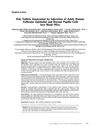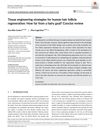Search
forLearn
2 / 2 resultslearn Neem Oil
natural substance from Neem tree with medicinal and pesticidal properties
Research
5 / 1000+ results
research Hair Follicle Generation by Injections of Adult Human Follicular Epithelial and Dermal Papilla Cells into Nude Mice
Injecting a mix of human skin and hair cells into mice can grow new hair.
research Interfollicular Epidermal Stem-Like Cells for the Recreation of the Hair Follicle Epithelial Compartment
Human skin cells with stem-like features can help create new hair follicles and sebaceous glands when combined with other cells.

research Expression Patterns of MITF During Human Cutaneous Embryogenesis: Evidence for Bulge Epithelial Expression and Persistence of Dermal Melanoblasts
Melanocyte precursors in human fetal skin follow a specific migration pattern and some remain in the skin's deeper layers.

research Human Epithelial Hair Follicle Stem Cells and Their Progeny: Current State of Knowledge, the Widening Gap in Translational Research and Future Challenges
We need more research to better understand human hair follicle stem cells for improved treatments for hair loss and skin cancer.

research Tissue Engineering Strategies for Human Hair Follicle Regeneration: How Far From a Hairy Goal?
Fully regenerating human hair follicles not yet achieved.
Community Join
5 / 418 resultscommunity Evidenced Based Meta-Analyses and Systemic Reviews of Androgenic Alopecia and Treatments
Evidence-based treatments for androgenic alopecia, such as minoxidil, finasteride, low-level laser light therapy, dutasteride, platelet-rich plasma, and topical ketoconazole. It discusses the efficacy, safety, and mechanism of action of these treatments, as well as future developments in understanding this polygenic condition.

community Compressed part of research of theory of androgenic/anabolitic balance. AGA h-responders analytic. Theory of physio-metabolitic method of anti AGA treatment
The treatment for androgenetic alopecia involves using finasteride and minoxidil with intense exercise and cold exposure to boost metabolism and reduce androgenic effects, potentially leading to hair regrowth. This approach may activate biological pathways for improved hair and overall health.
community Fevipiprant 2019!
The conversation discusses Fevipiprant, an asthma drug that may block CRTH2 and potentially stop male pattern baldness (MPB) without inhibiting DHT. It also mentions the use of finasteride and dutasteride for hair loss.
community UPDATE: The theory that explains everything. Please help me make this big!
Hair loss theory involves 3alpha-hydroxysteroid reductase (3AHD) converting DHT to androstenol. Discussion explores potential treatments and encourages more research.
community How many of you guys have taken accutane?
Accutane may accelerate hair loss in genetically predisposed individuals by affecting enzymes related to DHT metabolism. Some users report hair loss after taking Accutane, while others use treatments like finasteride and minoxidil to manage hair loss.